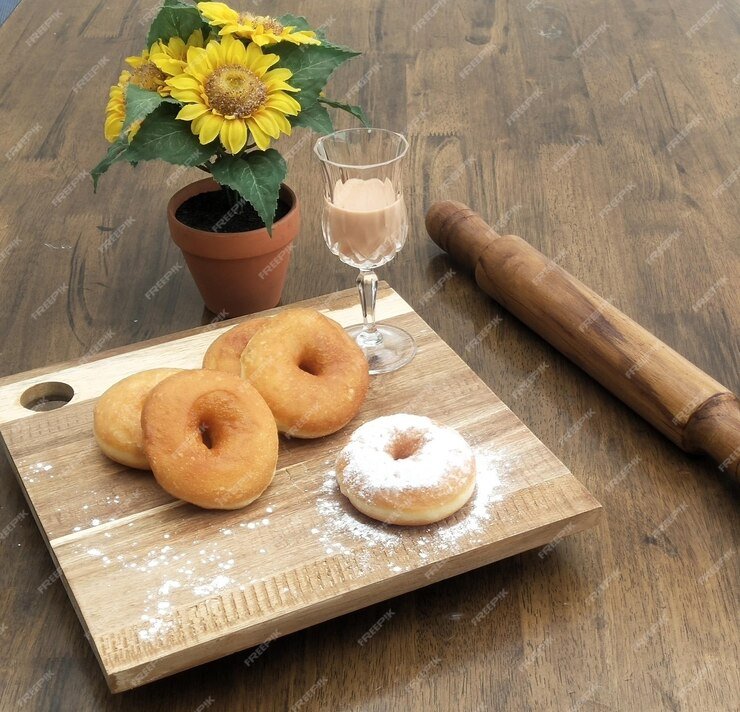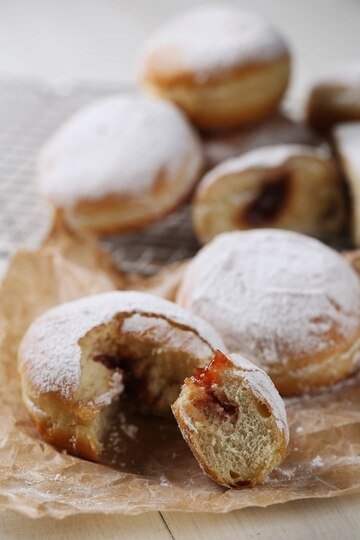If you’re craving something delicious and unique, this Italian Donuts Recipe is exactly what you need. These light, airy treats are a staple in many Italian kitchens, offering a sweet and comforting experience with every bite. Unlike your typical donuts, Italian donuts are often flavored with hints of citrus or anise, giving them a distinctive taste that’s both rich and refreshing.
Whether you’re making them for a special occasion or just as a sweet treat for yourself, they are sure to impress. The best part? They’re simple to make, with easy-to-find ingredients that result in a soft, fluffy texture on the inside and a crispy exterior.
This Italian Donuts Recipe not only brings a bit of Italian tradition to your kitchen but also fills your home with the warm, inviting aroma of freshly fried donuts. Ready to try something new and delicious? Let’s dive into this easy-to-follow Italian Donuts Recipe!
Ingredients For Making Italian Donuts Recipe
Making Italian donuts requires just a few basic ingredients that come together to create a deliciously fluffy, aromatic treat. The main ingredient for the dough is all-purpose flour, which forms the foundation of the donuts. To sweeten the dough, you’ll need sugar, while active dry yeast is essential for making the dough rise and creating the perfect texture.

Key Wet Ingredients
For the wet ingredients, milk adds softness to the dough, while eggs provide richness and structure. A bit of butter is also included to make the donuts tender and slightly buttery in flavor.
Flavorful Additions
What sets Italian donuts apart from others is the unique flavoring. Lemon zest is often added for a burst of citrusy freshness, giving the donuts a bright, aromatic touch. You can also use anise extract or anise seeds for a subtle, traditional Italian flavor. These ingredients elevate the flavor profile and give your donuts a distinctive taste.

Frying and Finishing Touches
To fry the donuts, you’ll need vegetable oil or canola oil for a crispy exterior. Once fried, the donuts are typically rolled in sugar or dusted with powdered sugar to finish them off with a sweet touch.
With these ingredients, you’ll be able to recreate a delicious Italian donut that’s light, flavorful, and perfect for any occasion!
Step-by-Step Instructions to Make Italian Donuts Recipe
Making Italian donuts at home is easier than you might think! With the right ingredients and a bit of patience, you can create these light, fluffy, and aromatic treats that will transport your taste buds straight to Italy. Follow this step-by-step guide to make the perfect Italian donuts from scratch.

Step 1: Prepare the Yeast Mixture
Start by activating the yeast, which is key to giving your donuts that fluffy texture. In a small bowl, combine warm milk (about 110°F or 43°C) with sugar and active dry yeast. Stir gently to dissolve and let it sit for about 5-10 minutes until the mixture becomes frothy. This means the yeast is active and ready to work its magic in the dough.
Step 2: Mix the Dry Ingredients
While the yeast is activating, mix the dry ingredients. In a large bowl, sift together all-purpose flour, a pinch of salt, and lemon zest (or orange zest if you prefer). The zest adds a fresh citrus aroma that is signature to Italian donuts. If you’re using anise extract or anise seeds, you can add them at this stage too for that signature flavor.
Step 3: Combine Wet and Dry Ingredients
Once the yeast mixture is ready, make a well in the center of the dry ingredients and pour in the yeast mixture, along with two beaten eggs and melted butter. Use a wooden spoon to mix everything together until a dough starts to form. The dough should be soft but not sticky. If it’s too wet, add a little more flour, a tablespoon at a time.
Step 4: Knead the Dough
Turn the dough out onto a lightly floured surface and knead it for about 5-8 minutes. The goal here is to develop the gluten, which will give your donuts their chewy, airy texture. The dough should become smooth and elastic. If it’s sticking to your hands, dust your hands and the dough with a bit of flour, but try not to add too much to avoid making the dough too dense.
Step 5: Let the Dough Rise
Once the dough is kneaded, shape it into a ball and place it in a lightly greased bowl. Cover the bowl with a clean kitchen towel or plastic wrap and let it rest in a warm place for about 1-1.5 hours, or until it has doubled in size. This is the crucial proofing step, where the yeast does its work and makes the dough light and fluffy.
Step 6: Shape the Donuts
Once the dough has risen, punch it down gently to release the air bubbles. Turn the dough out onto a floured surface and roll it out to about 1/2-inch thickness. Using a round cutter or the rim of a glass, cut out circles of dough. For the classic donut shape, use a smaller cutter to punch a hole in the center of each circle.
If you prefer filled Italian donuts, you can skip the hole and form small pockets of dough to fill with jam or chocolate before sealing the edges.
Step 7: Heat the Oil
In a large pot or deep fryer, heat vegetable oil or canola oil to 350°F (175°C). You’ll want enough oil for the donuts to float while frying. To test if the oil is hot enough, drop in a small piece of dough—if it sizzles and rises to the surface, the oil is ready.
Step 8: Fry the Donuts
Carefully drop a few donuts into the hot oil, being careful not to overcrowd the pot. Fry the donuts for about 2-3 minutes on each side, or until they are golden brown. Use a slotted spoon to remove the donuts and place them on a paper towel-lined plate to drain any excess oil.
Step 9: Coat the Donuts
While the donuts are still warm, roll them in granulated sugar or dust them with powdered sugar. You can also dip them in cinnamon sugar for extra flavor if you like.
Step 10: Serve and Enjoy!
Your homemade Italian donuts are now ready to be enjoyed! These donuts are best served fresh, while they’re still warm and fluffy. Pair them with a cup of coffee or a glass of dessert wine for the full Italian experience.
Tips and Tricks for Making Perfect Italian Donuts
Making Italian donuts can be a fun and rewarding experience, but to ensure they turn out perfectly every time, here are some helpful tips and tricks. These will elevate your homemade donuts and make the process even easier.
Use Fresh Yeast
The key to light and fluffy donuts is active, fresh yeast. Always check the expiration date of your yeast before using it, as expired yeast won’t activate properly and could result in dense donuts. To test if your yeast is still good, mix it with warm milk and sugar and wait for it to foam. If it doesn’t foam, it’s time to buy fresh yeast.
Don’t Skip the Resting Time
Allowing the dough to rest and rise is crucial for achieving that soft, airy texture. If you rush through this step, your donuts might turn out heavy and dense. Be patient and let the dough rise until it’s doubled in size. This step can take anywhere from 1 to 1.5 hours, depending on the warmth of your kitchen.
Maintain the Right Oil Temperature
The temperature of your frying oil makes a big difference in how the donuts cook. Too hot, and they will brown too quickly on the outside while staying raw on the inside. Too cold, and they’ll soak up too much oil, becoming greasy. Use a thermometer to keep the oil at a steady 350°F (175°C) for the best results.
Experiment with Flavors
Italian donuts have endless flavor possibilities. Feel free to experiment with different zests like orange or lime for a twist. If you love spices, try adding a pinch of cinnamon to the dough for extra warmth and depth. You can also try different fillings like chocolate or cream for a fun, indulgent treat.
Serve Them Fresh
Italian donuts are best enjoyed fresh and warm, so make them just before serving for that crispy, soft texture. If you have leftovers, store them in an airtight container, but be aware that they may lose some of their crispy texture the next day. You can always reheat them in the oven to crisp them up again!
Variations of Italian Donuts
Italian donuts are a versatile treat, and there are many delicious variations you can try to put your own twist on this classic recipe. Whether you’re in the mood for something fruity, filled, or spiced, these variations will take your homemade Italian donuts to the next level.
Zeppole (Italian Cream-Filled Donuts)
Zeppole are a popular variation of Italian donuts, typically filled with pastry cream, ricotta cheese, or whipped cream. They’re often served on special occasions, especially during holidays like St. Joseph’s Day. After frying, these donuts are dusted with powdered sugar and sometimes drizzled with chocolate or honey for added sweetness.
Sicilian Donuts (Sfingi)
Sicilian donuts, also known as sfingi, are slightly denser than traditional Italian donuts and are often flavored with citrus zest and cinnamon. These donuts are sometimes soaked in a light syrup or filled with custard, offering a richer flavor profile. They are a beloved treat in Sicily and are often served during the Carnival season.
Lemon or Orange Glazed Donuts
For a fresh twist, drizzle your donuts with a tangy lemon or orange glaze instead of rolling them in sugar. This citrusy glaze enhances the flavor of the donut, making it even more aromatic and refreshing. You can also mix in some zest for an extra burst of citrus.
Nutty Italian Donuts
For those who love crunch, you can coat your Italian donuts in chopped nuts such as pistachios, almonds, or hazelnuts after frying. This adds a lovely crunch and nutty flavor that pairs beautifully with the soft, airy dough.
Common Mistakes to Avoid When Making Italian Donuts
While making Italian donuts can be a fun and rewarding experience, there are a few common mistakes that can affect the final result. Avoid these pitfalls to ensure your donuts turn out perfectly every time.
Using Expired Yeast
One of the most common mistakes is using expired or inactive yeast. If your yeast isn’t fresh, your dough won’t rise properly, leading to dense donuts. Always check the expiration date on your yeast and test it before mixing it into the dough by activating it in warm milk and sugar.
Not Allowing Enough Rising Time
Rushing the rising process can lead to donuts that are heavy and lack the fluffy texture that makes them so delicious. Be patient and let the dough rest for the full amount of time, usually 1-1.5 hours, until it has doubled in size. This is key for a light and airy donut.
Incorrect Oil Temperature
Frying your donuts at the wrong oil temperature can result in greasy or unevenly cooked donuts. Too hot, and they’ll brown too quickly; too cold, and they’ll absorb too much oil. Use a thermometer to keep the oil around 350°F (175°C) for the best results.
Overcrowding the Frying Pan
Avoid overcrowding the donuts in the frying pan. If you place too many donuts in at once, the oil temperature will drop, causing the donuts to cook unevenly. Fry them in small batches for the crispiest, most even results.
What Are Italian Donuts?
Italian donuts, often known as zeppole or sfingi, are a traditional Italian treat that comes in various regional forms. Unlike typical donuts, they are usually lighter and airier, made with a dough that is fried until golden and then often rolled in sugar or filled with cream. They are perfect for special occasions, holidays, or just as a sweet snack to enjoy with coffee. Their flavor is often enhanced with citrus zest like lemon or orange and sometimes anise for a distinctive, aromatic taste.
How Do I Make Italian Donuts Light and Fluffy?
To make your Italian donuts light and fluffy, ensure you use fresh, active yeast and allow the dough to rise properly. This is crucial for achieving that airy texture. Don’t rush the resting time—let the dough double in size, usually 1-1.5 hours. Also, make sure your frying oil is at the right temperature (around 350°F or 175°C). Frying at the correct temperature ensures the donuts cook evenly, forming a golden, crispy exterior while keeping the inside soft and fluffy.
Can I Fill My Italian Donuts with Cream or Jam?
Yes, you can definitely fill your Italian donuts with cream, jam, or even chocolate! Zeppole, for example, are often filled with pastry cream or ricotta cheese. After frying the donuts, you can either inject the filling directly into the center or cut them open and spoon in the filling. These filled versions add richness and flavor to your donuts, making them even more indulgent.
How Do I Know When the Oil Is Ready for Frying?
To fry your Italian donuts perfectly, it’s essential to ensure the oil is at the right temperature. The best way to check is by using a kitchen thermometer to keep the oil at 350°F (175°C). If you don’t have a thermometer, you can drop a small piece of dough into the oil. If it sizzles and rises to the surface within a few seconds, the oil is ready. Avoid frying at too high or too low a temperature to prevent greasy or undercooked donuts.
Can I Make Italian Donuts Ahead of Time?
While Italian donuts are best enjoyed fresh, you can make them ahead of time if needed. If you’re preparing them in advance, store them in an airtight container at room temperature.
The texture will not be as crispy, but you can refresh them by reheating in the oven or a toaster oven to bring back some of their crispiness. For filled donuts, be sure to store them carefully, as fillings like cream or jam may soften the dough over time.
Conclusion
Italian donuts are a delightful treat that brings a touch of Italian tradition to your kitchen. Whether you choose the classic fried version, experiment with fillings like cream or jam, or try different flavor variations, these donuts are sure to impress. The key to perfecting them lies in using fresh yeast, allowing the dough to rise properly, and frying at the right temperature.
With a bit of patience and attention to detail, you can enjoy warm, fluffy, and aromatic donuts that are perfect for any occasion. So, gather your ingredients, follow the steps, and indulge in these delicious Italian treats that will transport your taste buds straight to Italy!

